Reviews

KTM AER MX1 Air Fork Revalve featured in Motocross Action Magazine
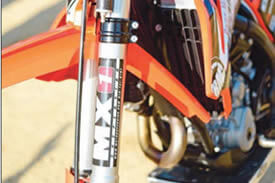
Regardless of what a small handful of naysayers believe, the WP AER air forks on the 2017 KTMs and Huskys are the best production air forks ever made. They are simple to set up, easy to live with and well damped; however, no fork is perfect. That even goes for Yamaha's heralded Kayaba SSS forks. Most MXA test riders feel that the AER air forks, like the 4CS and bladder forks before them, are too quick in the mid-stroke, especially in consecutive braking bumps. The damping before that is well modulated, and the ramp-up of the air pressure after that is more than adequate to keep the AER forks from bottoming. But, in the nether region, between the middle of the stroke and bottoming control, the AER forks flutter.
MXA had excellent luck with MX1's Advanced Progressive System (APS) on the older WP 4CS forks, so we were interested in what suspension guru Dick Wilk could do for the latest AER air fork. First, before we decided to test Dick's MX1 fork mods, we had to make sure that he was working on the same area of concern as we were, because otherwise we'd be going at cross-purposes. Luckily, Dick succinctly described what his new AER re-valve mod fixed and since it matched what we wanted fixed, we were off to the races
Every test rider felt that the MX1-modified forks followed the ground much better than the stockers. They didn't chatter off little bumps; instead, they mimicked the feel of WP Cone Valve forks, which are superb at tracking across rough ground without any lift-off. This is a very good mod for a discerning AER rider. It is also a must-do for 2016-17 KTM and Husky owners because it turns out that the MX1 mods were very close to what the KTM R&D department did with the 2018 forks.
Husky 250 Featured in Motocross Action Magazine
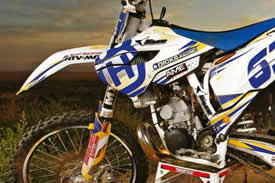
The stock forks on the Husky TC250 are known to be harsh on the top stroke and flow through with ease. MX1 softened the up the top of the stroke and made it progressively stiffer the further down it traveled, It was a good setup for Vet riders.
As for as the suspension goes, Dick said that is wasn't spec'd for a former AMA national ride, unless they had retired about 15 years earlier. It was set up for Vet riders and was plush and supple for that reason. In the end, all of our test riders thought that the MX1 suspension was on the soft side, but a few clicks in on the compression adjuster front and rear made them happy, well if didn't make the pros happy.
MX1 suspension was up front about this bike being setup for Vet riders, but we always test the bikes with riders big and small, fast and slow. Why? More times than can be counted, the wrecking crew has come across bike and products that are designed for one group but work better for another. Typically, most suspension shops go too stiff, so for MX1 to go too soft was a breath of fresh air.
KTM 300 SX Featured in Motocross Action Magazine.
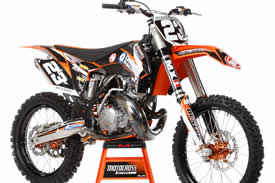
We did the suspension on this bike for Chuck Sun to race the World 2-stroke championship at Glen Helen. The forks featured our exclusive "positive seal" valving system that holds it up in the stroke for maximum travel availability ($195). The shock featured our proprietary shock piston that gets rid of the wallowy action of the stock unit ($350).If you are fast, this combination works best. The MXA pro's loved it. Please request 300 SX settings in the special request section of the service order form. If you ride at a lower level, please let us know.
CRF450 MX1 Suspension for Motocross.com.
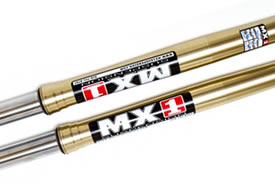
Richard Wilk of MX1 Suspension has been at the game for decades and has a knack for tuning motocross, off-road and supermoto suspension. MX1 is already up to speed with the all-new air spring fork and has settings for the coil-less jobs. They pretty much service all brands of moto suspension from simple oil changes, complete revalve to complete rebuilds if needed. In addition to suspension service, they also offer specialized Carburetor Mods and aftermarket products over at their sister shop Dick's Racing.
Here we had a 2013 Honda CRF450R tuned up. The goal was to smooth out the fork in the chop and small bumps and offer more bottoming resistance toward the latter part of the stroke. The shock was sprung for a heavier rider with a 5.9 spring and the valving was tuned to offer better rebound control throughout the stroke.
When it comes to CRF suspension, MX1 has you covered. Whether it's the 02-08 Showa components, or the newer 09-12 KYB components on the 450, 2010-13 CRF 250 Showa stuff or even the latest Air Forks on the all new 2013 CRF450, you can count on MX1 to deliver superb performance. We have been racing CRFs from the beginning and have spent countless hours testing our specs. We are sure you will be thrilled with the results.
Honda CRF450R MX1 Suspension in Motocross Action Magazine.
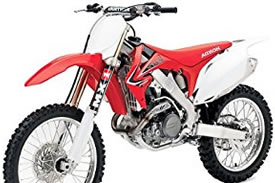
July 2012 Motorcross Action Magazine Tested on our 2012 CRF450R MX1 supsension mods. They had nothing but good things to say about it. The forks mid stroke harness was eliminated. Good stuff from MX1 Suspension.
KTM 350SXF MX1 Fork/Shock Suspension Mods in Motorcross Action Magazine.
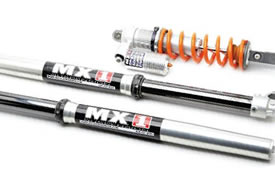
Here's a list of things that stand out with MX1 Suspension's KTM 350SXF mods.
Fork performance. What a difference. As a quick fix, the MXA test crew had installed stiffer 0.50 fork springs. Although this helped, it wreaked havoc on the stock damping—which was too light in compression and rebound. MX1's revalve provided the oil control necessary to make the forks feel more fluid and metered through the middle of the stroke. Additionally, the clicker range was increased, which allowed the same forks to be used by Pros and Novices with just a few clicks.
Shock performance. Since the KTM 350SXF races in the same class and weighs within five pounds of the KTM 450SXF, it was obvious that it needed a stiffer shock spring. MX1 elected to go with a 5.8 shock spring and up the damping capabilities of the WP shock. Thanks to a larger shock reservoir, they could use a rubber bladder (which is hard to get to work in the stock reservoir). The combination of the proper shock spring, stiffer valving and more compliant reservoir allowed for a wider range of options. Most significant, the rear didn't drop under acceleration as the stocker does.
Yamaha YZ450F MX1 Fork/Shock Revalve Featured in Motocross Action Magazine
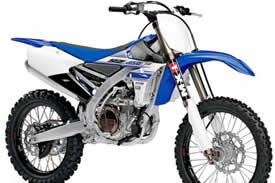
A first-class fix for the front and rear Kayaba SSS suspension components on 2010-16 YZ450Fs. Here's a list of things that stand out with MX1 Suspension's YZ450F setup.
Forks. The biggest problem with the YZ450F forks is that they are out of balance with the stiffer rear. Thus, if you can only afford to fix one end, work on the shock. If you would like to get both ends super-tuned, however, here is what MX1 Suspension did to our YZ450F forks. First, they installed stiffer 0.49 kg/mm fork springs. The stiffer spring rate held the forks higher in their stroke, but, most importantly, it allowed MX1 to change the compression and mid-valve to a much plusher setting. This allowed the forks to flow better through their travel, while depending on the spring for bottoming control. Unlike other Kayaba forks, the YZ450F forks do not have a "free bleed" hole in the piston, which means most previous Kayaba fork knowledge cannot be applied to the YZ450F. MX1 tried multiple rebound settings to compensate for the lack of free bleed, eventually finding the right combination to match the springs. Every MXA test rider loved the forks. One or two clicks in either direction made a noticeable difference in feel.
Shock. We stayed with the stock shock spring. It is well-suited to the target weight of the typical YZ450F rider. The main goal was to get plusher compression without introducing blow-through. How can you make the shock feel softer without having it bottom? MX1's answer was to reduce the size of the shock's "free bleed adjuster passage." This mod was combined with lighter compression damping to make the shock move more freely in the first two-thirds of the stroke. In addition, an old school air bleed circuit was added to ensure air-free performance. In MXA's opinion, the MX1 shock would have worked well with the stock forks because it would have lessened the stinkbug stance and allowed the chassis to ride level. But the combination of front and rear MX1 mods was pretty sweet.
Fork adjusters. MX1 built us a set of special compression adjusters that could be clicked by hand. This made testing and setup much easier than trying to wedge a screwdriver into the Kayaba slot. Unfortunately, making the KTM-style knobs is a complicated process, and the cost is $145.00.